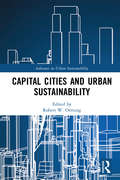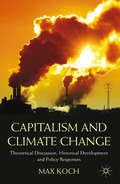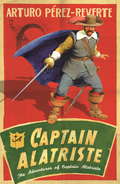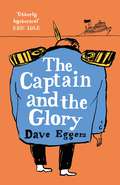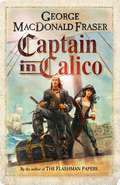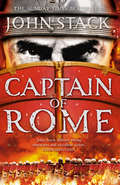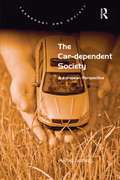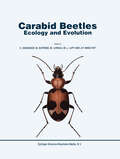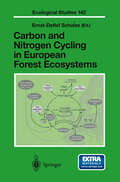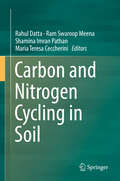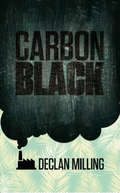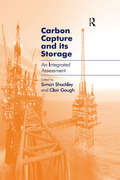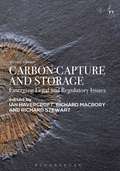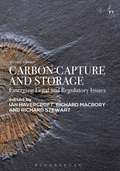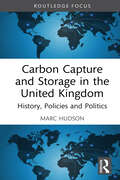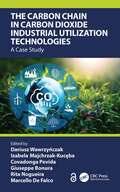- Table View
- List View
Capital Cities and Urban Sustainability (Advances in Urban Sustainability)
by Robert W. OrttungCapital Cities and Urban Sustainability examines how capital cities use their unique hub resources to develop and disseminate innovative policy solutions to promote sustainability. Cities are taking a leading role in defining a sustainable future at a time when national, state, and regional governments in several countries do not provide sufficient leadership. Capital cities stand out among cities as likely leading drivers in the effort to empower sustainable innovation as they provide a hub for connecting a variety of key constituencies. While acknowledging the successes capital cities have achieved, the international, multi-disciplinary contributors to this work discuss how there is room to do more and improve. The promotion of specific sustainability policies in crucial areas such as clean water provision, high tech innovation, public procurement contracting, and improving flood control in capital cities is examined through various global case studies. The examples range from relatively rich capital cities, such as Copenhagen, where the well-financed hub would be expected to succeed in generating sustainable policies, to poorer cities such as Phnom Penh, where such an optimistic outcome can seem less likely.
Capital Cities and Urban Sustainability (Advances in Urban Sustainability)
by Robert W. OrttungCapital Cities and Urban Sustainability examines how capital cities use their unique hub resources to develop and disseminate innovative policy solutions to promote sustainability. Cities are taking a leading role in defining a sustainable future at a time when national, state, and regional governments in several countries do not provide sufficient leadership. Capital cities stand out among cities as likely leading drivers in the effort to empower sustainable innovation as they provide a hub for connecting a variety of key constituencies. While acknowledging the successes capital cities have achieved, the international, multi-disciplinary contributors to this work discuss how there is room to do more and improve. The promotion of specific sustainability policies in crucial areas such as clean water provision, high tech innovation, public procurement contracting, and improving flood control in capital cities is examined through various global case studies. The examples range from relatively rich capital cities, such as Copenhagen, where the well-financed hub would be expected to succeed in generating sustainable policies, to poorer cities such as Phnom Penh, where such an optimistic outcome can seem less likely.
Capitalism and Climate Change: Theoretical Discussion, Historical Development and Policy Responses
by Max KochThis book discusses climate change as a social issue, examining the incompatibility of capitalist development and Earth's physical limits and how these have been regulated in different ways. It addresses the links between modes of consumption, energy regimes and climate change during Fordism and finance-driven capitalism.
Captain Alatriste: A swashbuckling tale of action and adventure (The Adventures of Captain Alatriste)
by Arturo Perez-ReverteA thrilling,swashbuckling adventure series starring the Spanish D'ArtagnanCaptain Alatriste is a swordsman for hire in Spain at a timewhen Court intrigue is high and the decadent young king has dragged the countryinto a series of disastrous wars. As a hired blade, Alatriste becomes involvedin many political plots and must live by his wits. He comes face to face withhired assassins, court players, political moles, smugglers, pirates and ofcourse, the infamous Spanish Inquisition...Introducing Iñigo Balboa, Alatriste's young page; Quevedo, asubversive poet who likes to start fights in the local tavern, the elegantCount of Guadalmedina, and the beautiful but deadly Angelica de Alquezar,CAPTAIN ALATRISTE is a thrilling tale of adventure and intrigue that will appealto anyone who enjoyed The Three Musketeers.
The Captain and the Glory: An Entertainment
by Dave EggersA hilarious, biting satire of the United States and its unpredictable leader from the best-selling author of The CircleThe grand ship Glory has been skilfully captained for years, but when its well-loved old skipper decides to step down, a new leader thrusts himself forward and a new era begins.The new Captain is vulgar, bumbling and inexplicably confident. With no knowledge of nautical navigation or maritime law - nor even, as he has repeatedly remarked, a particular liking for boats - he solemnly swears to shake things up. Together with his band of petty thieves and confidence men known as the Upskirt Boys, the Captain enthralls his passengers: writing his dreams and notions on the cafeteria whiteboard, boasting of his exemplary anatomy, devouring cheeseburgers, and tossing anyone who dissatisfies him overboard. Until one day a famous pirate, long feared by passengers of the Glory but revered by the Captain for how phenomenally masculine he looks without a shirt while riding a horse, appears on the horizon . . .
Captain Hornblower R.N.: Hornblower and the 'Atropos', The Happy Return, A Ship of the Line (A Horatio Hornblower Tale of the Sea)
by C. S. Forester"Hornblower and the Atropos" skippering the flagship for Nelson's funeral on the Thames is not Hornblower's idea of thrilling action. But soon his orders come, and he sets sail for the Mediterranean in the Atropos. 'Battle, storm, shipwreck, disease - what were the chances that he would never come back again?' "The happy return" Hornblower sails the South American waters and comes face to face with a mad, messianic revolutionary in a novel that ripples with risk and gripping adventure. "a ship of the line" commando raids, hurricanes at sea, the glowering menace of Napoleon's onshore gun batteries - Hornblower must deal with them all as he sails his ship to the Spanish station. Throughout his escapades Forester remains gallant, resourceful and courageous - the embodiment of all the most vivid in a great naval tradition.
Captain in Calico
by George MacDonald FraserThe first unpublished novel from the historical fiction legend, George Macdonald Fraser, featuring the unscrupulous and brilliantly entertaining pirate, Calico Jack Rackham.
Captain of Rome: Ship Of Rome, Captain Of Rome, Master Of Rome (Masters of the Sea)
by John StackThe second installment of the thrilling maritime adventure; two mighty empires battle each other for control of the high seas.
Capybara: Biology, Use and Conservation of an Exceptional Neotropical Species
by José Roberto Moreira, Katia Maria P. M. B. Ferraz, Emilio A. Herrera and David W. MacdonaldThe capybara is the neotropical mammal with the highest potential for production and domestication. Amongst the favorable characteristics for domestication we can list its high prolificacy, rapid growth rate, a herbivorous diet, social behavior and relative tameness. The genus (with only two species) is found from the Panama Canal to the north of Argentina on the east of the Andes. Chile is the only country in South America where the capybara is not found. The species is eaten all over its range, especially by poor, rural and traditional communities engaged in subsistence hunting. On the other hand, in large urban settlements wildlife is consumed by city dwellers as a delicacy. The sustainable management of capybara in the wild has been adopted by some South American countries, while others have encouraged capybara rearing in captivity.
The Car-dependent Society: A European Perspective (Transport and Society)
by Hans JeekelCars are essential in modern Western societies. Some even say that our modern lifestyles would have been impossible without cars. The dependency of Western societies on our cars is a unique situation in history, but does not get much attention; car use is seen as just a normal situation. The population at large knows the risks, knows the disadvantages, experiences the advantages and keeps driving. Using data from Western Europe, this book examines three key themes: frequent car use, car dependence, and the future of passenger car mobility in societies. In conclusion, in modern Western risk societies, more attention needs to be paid to car dependence, its driving forces, its advantages, its problems and challenges for the future.
The Car-dependent Society: A European Perspective (Transport and Society)
by Hans JeekelCars are essential in modern Western societies. Some even say that our modern lifestyles would have been impossible without cars. The dependency of Western societies on our cars is a unique situation in history, but does not get much attention; car use is seen as just a normal situation. The population at large knows the risks, knows the disadvantages, experiences the advantages and keeps driving. Using data from Western Europe, this book examines three key themes: frequent car use, car dependence, and the future of passenger car mobility in societies. In conclusion, in modern Western risk societies, more attention needs to be paid to car dependence, its driving forces, its advantages, its problems and challenges for the future.
Carabid Beetles: Ecology and Evolution (Series Entomologica #51)
by J-P. Maelfait K. Desender M. Dufrêne M. Loreau M. L. LuffCaravan Cookbook: Delicious, Easy-to-make Recipes In The Great Outdoors
by Monica RivronA book of delicious, easy-to-make recipes in the great outdoors. Food is often one of the most enjoyable elements of a holiday, but nobody wants to spend hours slaving in a hot, micro-kitchen with limited supplies.
Carbon and Nitrogen Cycling in European Forest Ecosystems (Ecological Studies #142)
by Ernst-Detlef SchulzeThis volume quantifies carbon storage in managed forest ecosystems not only in biomass, but also in all soil compartments. It investigates the interaction between the carbon and nitrogen cycles by working along a north-south transect through Europe that starts in northern Sweden, passes through a N-deposition maximum in central Europe and ends in Italy. For the first time biogeochemical processes are linked to biodiversity on a large geographic scale and with special focus on soil organisms. The accompanying CD-ROM provides a complete database of all flux, storage and species observations for modellers.
Carbon and Nitrogen Cycling in Soil
by Rahul Datta Ram Swaroop Meena Shamina Imran Pathan Maria Teresa CeccheriniSeveral textbooks and edited volumes are currently available on general soil fertility but‚ to date‚ none have been dedicated to the study of “Sustainable Carbon and Nitrogen Cycling in Soil.” Yet this aspect is extremely important, considering the fact that the soil, as the ‘epidermis of the Earth’ (geodermis)‚ is a major component of the terrestrial biosphere. This book addresses virtually every aspect of C and N cycling, including: general concepts on the diversity of microorganisms and management practices for soil, the function of soil’s structure-function-ecosystem, the evolving role of C and N, cutting-edge methods used in soil microbial ecological studies, rhizosphere microflora, the role of organic matter (OM) in agricultural productivity, C and N transformation in soil, biological nitrogen fixation (BNF) and its genetics, plant-growth-promoting rhizobacteria (PGPRs), PGPRs and their role in sustainable agriculture, organic agriculture, etc. The book’s main objectives are: (1) to explain in detail the role of C and N cycling in sustaining agricultural productivity and its importance to sustainable soil management; (2) to show readers how to restore soil health with C and N; and (3) to help them understand the matching of C and N cycling rules from a climatic perspective.Given its scope, the book offers a valuable resource for educators, researchers, and policymakers, as well as undergraduate and graduate students of soil science, soil microbiology, agronomy, ecology, and the environmental sciences. Gathering cutting-edge contributions from internationally respected researchers, it offers authoritative content on a broad range of topics, which is supplemented by a wealth of data, tables, figures, and photographs. Moreover, it provides a roadmap for sustainable approaches to food and nutritional security, and to soil sustainability in agricultural systems, based on C and N cycling in soil systems.
Carbon Black
by Declan MillingIt's the end of the decade and the international response to climate change has defaulted to a piecemeal carbon market, which a new UN body is trying to make work. But the carbon market has become a battleground between anti-capitalist activists, now aggressively militant, and market proponents. And there are others, intent on protecting the status quo, and their financial interests in it. Emil Pfeffer, the new body's Director of Market Integrity, thinks he's making a difference, but he hasn't really left the comfort zone of his cocooned bureaucrat's existence. He's addressing C-World, the biggest carbon market conference and trade fair on the global circuit, when a questioner challenges the integrity of one of Emil's own staff, allegedly under arrest. Events half a world and, for Emil, an earlier lifetime away in Papua New Guinea are about to change everything. His cosseted, self-contained, somewhat self-satisfied world is about to be turned upside down. Risks need to be taken, sacrifices made, to achieve what is worth saving - his organisation's credibility and purpose. His colleagues' reputations. But then he realizes, it's his life that's on the line.
Carbon Capture and its Storage: An Integrated Assessment
by Clair GoughClimate change is arguably the most important environmental issue that the world currently faces. Carbon Capture and Storage (CCS) offers the possibility of significant reductions in the volume of CO2 released into the atmosphere in the near to medium term. As a fairly new technology that has not been widely adopted, there remain some uncertainties related to both viability and desirability. This book discusses the key issues with regard to technical and legal feasibility, economic viability and public and stakeholder perceptions. It also provides recommendations for policy and future research.
Carbon Capture and its Storage: An Integrated Assessment
by Clair GoughClimate change is arguably the most important environmental issue that the world currently faces. Carbon Capture and Storage (CCS) offers the possibility of significant reductions in the volume of CO2 released into the atmosphere in the near to medium term. As a fairly new technology that has not been widely adopted, there remain some uncertainties related to both viability and desirability. This book discusses the key issues with regard to technical and legal feasibility, economic viability and public and stakeholder perceptions. It also provides recommendations for policy and future research.
Carbon Capture and Storage: Emerging Legal and Regulatory Issues
by Ian Havercroft Richard Macrory Richard StewartCarbon Capture and Storage (CCS) is increasingly viewed as one of the most significant ways of dealing with greenhouse gas emissions. Critical to realising its potential will be the design of effective legal regimes at national and international level that can handle the challenges raised but without stifling a new technology of potential great public benefit. These include: long-term liability for storage; regulation of transport; the treatment of stored carbon under emissions trading regimes; issues of property ownership; and, increasingly, the sensitivities of handling the public engagement and perception. Following its publication in 2011, Carbon Capture and Storage quickly became required reading for all those interested in, or engaged by, the need to implement regulatory approaches to CCS. The intervening years have seen significant developments globally. Earlier legislative models are now in force, providing important lessons for future legal design. Despite these developments, the growth of the technology has been slower in some jurisdictions than others. This timely new edition will update and critically assess these updates and provide context for the development of CCS in 2018 and beyond.
Carbon Capture and Storage: Emerging Legal and Regulatory Issues
by Ian Havercroft Richard Macrory Richard StewartCarbon Capture and Storage (CCS) is increasingly viewed as one of the most significant ways of dealing with greenhouse gas emissions. Critical to realising its potential will be the design of effective legal regimes at national and international level that can handle the challenges raised but without stifling a new technology of potential great public benefit. These include: long-term liability for storage; regulation of transport; the treatment of stored carbon under emissions trading regimes; issues of property ownership; and, increasingly, the sensitivities of handling the public engagement and perception. Following its publication in 2011, Carbon Capture and Storage quickly became required reading for all those interested in, or engaged by, the need to implement regulatory approaches to CCS. The intervening years have seen significant developments globally. Earlier legislative models are now in force, providing important lessons for future legal design. Despite these developments, the growth of the technology has been slower in some jurisdictions than others. This timely new edition will update and critically assess these updates and provide context for the development of CCS in 2018 and beyond.
Carbon Capture and Storage in the United Kingdom: History, Policies and Politics (Routledge Focus on Energy Studies)
by Marc HudsonThis book is a concise but comprehensive guide to the history, present and possible futures of carbon capture and storage policy and action in the United Kingdom (UK).There have been multiple failed starts, promises and “last chances” for carbon capture and storage (CCS) in Europe, North America, China and Australia, but thus far it has repeatedly collided with the political and economic realities that the technology is too expensive and complicated to gain and keep policymakers’ support. However, in the UK that might be changing, with explicit government support for CCS to help decarbonise industry. Set within the broader context of global interest in CCS, this book first outlines the technologies involved in the types of capture technology, transport options and storage options in the UK. It then briefly introduces an overarching policy analysis framework (John Kingdon’s multiple streams approach) and uses it to give an account of the long history of CCS interest and efforts in three chapters covering the 1970s to 2002, 2003 to 2015 and 2016 to the present day. Marc Hudson focusses on the various arguments made for the introduction of CCS, and the slowly shifting coalitions of actors who make those arguments, while contrasting these with the perspectives of those opposed to CCS.This book will be of great interest to students, scholars and policymakers researching and working in the field, as well as the related areas of energy policy, energy transitions and climate change.
Carbon Capture and Storage in the United Kingdom: History, Policies and Politics (Routledge Focus on Energy Studies)
by Marc HudsonThis book is a concise but comprehensive guide to the history, present and possible futures of carbon capture and storage policy and action in the United Kingdom (UK).There have been multiple failed starts, promises and “last chances” for carbon capture and storage (CCS) in Europe, North America, China and Australia, but thus far it has repeatedly collided with the political and economic realities that the technology is too expensive and complicated to gain and keep policymakers’ support. However, in the UK that might be changing, with explicit government support for CCS to help decarbonise industry. Set within the broader context of global interest in CCS, this book first outlines the technologies involved in the types of capture technology, transport options and storage options in the UK. It then briefly introduces an overarching policy analysis framework (John Kingdon’s multiple streams approach) and uses it to give an account of the long history of CCS interest and efforts in three chapters covering the 1970s to 2002, 2003 to 2015 and 2016 to the present day. Marc Hudson focusses on the various arguments made for the introduction of CCS, and the slowly shifting coalitions of actors who make those arguments, while contrasting these with the perspectives of those opposed to CCS.This book will be of great interest to students, scholars and policymakers researching and working in the field, as well as the related areas of energy policy, energy transitions and climate change.
The Carbon Chain in Carbon Dioxide Industrial Utilization Technologies: A Case Study
by Dariusz Wawrzy 324 Czak Izabela Majchrzak-Kucę Ba Covadonga Pevida Giuseppe Bonura Rita Nogueira Marcello De FalcoA shift towards implementation of renewable energy has disadvantages, such as power availability, storage capacity, and accompanying costs, and therefore the potential of clean fossil fuel technologies to ensure the stability of electricity generation needs to be reconsidered until these challenges will be overcome. These clean technologies can help prevent the greenhouse effect and, at the same time, guarantee energy security, as coal is a widespread, price-stable raw material that is available in large quantities. This book focuses on the carbon chain, starting from the formation of CO2, through its capture, possible cleaning, to the production of useful products such as dimethylether, methanol, and carbonated cement prefabricates. The comprehensive case study presents the research results of an international team established within the "CCS-CCU technology for carbon footprint reduction using bio-adsorbents" (BIOCO2) project.
The Carbon Chain in Carbon Dioxide Industrial Utilization Technologies: A Case Study
by Dariusz WawrzyńczakA shift towards implementation of renewable energy has disadvantages, such as power availability, storage capacity, and accompanying costs, and therefore the potential of clean fossil fuel technologies to ensure the stability of electricity generation needs to be reconsidered until these challenges will be overcome. These clean technologies can help prevent the greenhouse effect and, at the same time, guarantee energy security, as coal is a widespread, price-stable raw material that is available in large quantities. This book focuses on the carbon chain, starting from the formation of CO2, through its capture, possible cleaning, to the production of useful products such as dimethylether, methanol, and carbonated cement prefabricates. The comprehensive case study presents the research results of an international team established within the "CCS-CCU technology for carbon footprint reduction using bio-adsorbents" (BIOCO2) project.
